Primary Divisions
We must not forget that it was the Hindus who discovered what is known as the precession of the Equinoxes, and in their calculation such an occurrence takes place every 25,827 years. Our modern science, after labors of hundreds of years has simply proved them to be correct….Count Viscount Cheiro
1.1 Time and Space
Time and space are like endless rings without a beginning and without an end. The definition of the beginning of a linear time scale or the starting point of the Universe has been the vexed question of many a thinker and this thought leads the mind to a definition of God as being imperceptible. The great Vedic thinkers personified God as Kalapurusha[1] and harmonized these two concepts of time and space into the four-dimensional model of Bhachakra (geocentric zodiac). Normally the Bhachakra is represented as a two dimensional figure for easy reading on paper, but the other dimensions of a dynamic linear time and the vertical declination of the planets were also examined and noted. Thus, the first and foremost point to bear in mind is that every division of the zodiac has a similar or matching division of time. As we study each of the divisions, we will also examine the time measure represented by it and will get additional clues to interpret results and delineate the effect of time on the division.
1.2 Rasi & Nakshatra
The division of the zodiac into twelve signs and twenty seven (or twenty eight Nakshatra) is the primary division in the paradigm of Vedic Astrology. Every now and then a new planet is seen and the doubts arise in the minds of the learned on the continued validity of the twelve sign zodiac. To clear these doubts, it is necessary to understand the basis of this primary division called Rasi. The zodiac of 12 signs and 27 constellations was prepared by carefully observing the movement of the Sun and Moon in the geocentric model of the universe.
1.2.1 Rasi – twelve Sun signs.
The relative motion between the Sun & Moon shows that the Synodical Month (new moon to new moon or full moon to full moon) is 29D 12H 44M 3S = 29.53059D. Rounding off to the next higher integer we get 30 days during which, the average solar motion is 30 Degrees. Finally, dividing the Bhachakra of 360 degrees by 30, we get 12 signs, or the 12 sun signs as the Sun[2] gets over-lordship of all signs being their pater. The twelve signs are Mesha (Aries), Vrisabha (Taurus), Mithun (Gemini), Karkata (Cancer), Simha (Leo), Kanya (Virgo), Tula (Libra), Vrischika (Scorpio), Dhanus (Sagittarius), Makara (Capricorn), Kumbha (Aquarius) and Meena (Pisces).
Figure 4 : The Sun sign Zodiac
This method of division of the Zodiac into two halves is based on the distance of the sun from the earth. This divides the zodiac along an imaginary line passing through the zero degrees of Leo and Zero degrees of Aquarius into two halves. Half or Hora is derived from the word Aho-Ratra[3] indicating the two-fold divisions of the day into equal halves of light and darkness. Thus, this division of the zodiac was into the two parts called Solar and Lunar halves[4] or Surya Hora and Chandra Hora respectively. The solar half or Surya Hora included the six signs in the zodiacal order from Leo to Capricorn and the lunar half or Chandra Hora included the six signs from Cancer to Aquarius in the reverse order. This division has nothing to do with Ayana. The Sun and Moon own adjoining signs (i.e. Leo & Cancer respectively) in their Hora’s while the five other planets in the order of Mercury, Venus, Mars, Jupiter and Saturn (based on their geographical distances from the Sun i.e. Mercury is closest and Saturn is the most distant) shall own the signs in their proximity to Leo (and Cancer) reckoned in the zodiacal (or reverse) order[5] (Figure -2)
1.2.3 Hora – (based on solstice)
The Rishi’s also observed the two solstices’ where the length of the day (i.e. daylight duration) was the longest and shortest respectively called the summer and winter solstice[6]. The Summer solstice is the longest day and marked the end of the hot summer season and beginning of the rainy season. So also the winter solstice marked the end of the long nights. Thus, the zodiac was divided into two halves along an imaginary line passing through the Zero Degrees of Cancer and Zero Degrees of Capricorn, which showed the position of the Sun at these two extreme points of longest day and longest night. This formed the two Ayana or halves of the zodiac comprising three seasons each. The specific terms used are Uttar-Ayana or Northern Goal and Dakshin-Ayana or Southern- Goal and refers to the ‘goal’ of the Sun as it seeks to reach the northernmost point of the zodiac (i.e. Zero degrees of Cancer) or southern-most point (i.e. zero degrees of Capricorn). This can also refer to the goal of seeking the northernmost latitude[7], which coincides with summer solstice, or the southernmost latitude[8], which coincides with winter solstice.
Figure 6 : Ayana
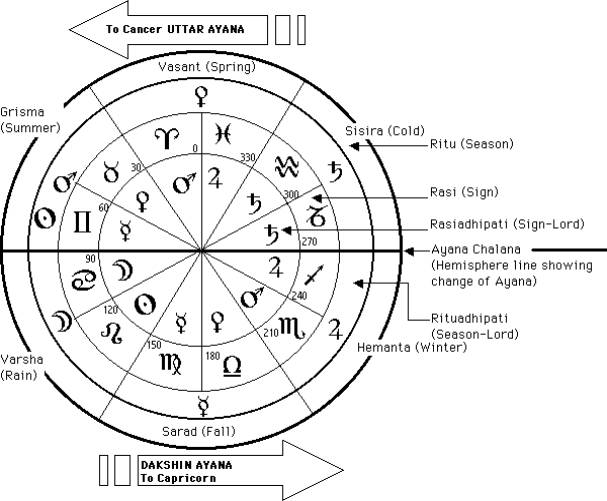
1.2.4 Kendra (Quadrant)
The beginning of the zodiac was fixed based on the position of the sun on equinoxes i.e. when the days and nights are equally long and this was at the zero degree of Aries and Libra. In this manner, the four crucial points of the zodiac were determined as zero degrees of Aries, Cancer, Libra and Capricorn. The Rishi’s realized that there were actually two zodiac’s – one where the solar system could be considered as an independent system in itself and another in which the solar systems movement around another ellipse center called VISHNU-NABHI is also accounted for. These two zodiac systems are called Sayana (Tropical) and Nirayana (Sidereal) Bhachakra. The primary difference between the two being the motion of the solar system in the universe which is measured by the period of precession of the equinoxes – 25,800 years and when calculated from the point when the same is zero (i.e. sidereal and tropical zodiac coincide) is called Ayanamsa [9] . Now, the difference between the starting points of the two zodiac’s at any point of time is called Ayanamsa. In the concept of the Hindu calendar[10] we realize that Varahamihira’s advocation of using the Suklanta Masa had a lot to do with the nomenclature of the Months on the basis of the normal Nakshatra position of the Full Moon and this determined the start of each lunar month (and not the Amanta Masa system as is in vogue in most of India today). In any case the star ‘Chitra’ was observed as the point of fixation and ‘Chitra Paksha’ referring to the opposite point from ‘Chitra [11]’ represents the beginning of the zodiac.
The basic point is that the zodiac was divided into four parts of ninety degrees each by the four points representing the beginning of Aries, Cancer, Libra and Capricorn and that these four points defined the four goals of human existence as (a) Dharma – righteousness and adherence to natural and societal principles (b) Moksha –Spirituality and emancipation from the cycle of rebirth, (c) Kaama – existence of desires and their fulfillment or denial as the cause of rebirth and (d) Artha – wealth. The four parts, on the other hand, divided the life into four ashrams, which form the foundation of Hinduism. This is also the concept in ‘Chatuspada [12] Dharma’.
The Sankhya Shastra teaches extensively about the Pancha Tatwa or the five forms of existence of all bodies. These forms of existence are (1) Prithvi (Solid state), (2) Jala (Liquid state), (3) Vayu (Gaseous state), (4) Agni (Energy state) and (5) Akash (ethereal or vacuum state). Vacuum permeates the entire universe and hence, the Akash Tatwa is present throughout the Bhachakra. The other four Tatwa were found to be in a predominant form in Aries (Agni), Cancer (Jala), Libra (Vayu) andCapricorn (Prithvi).
1.2.5 Trikona (Trine)
In a similar manner, the Trikona (trine) should also be understood as being the division of time into three aspects of past, present and future. Using (a) Manu Smriti statement that ‘a day in the life of the Gods is a year in human life’ we arrive at the basic equation of 1 Deg (=day motion of Sun) representing 1 year in Human life, and (b) Parasara’s statement that the Param Ayus for human beings is 120 years, we arrive at the angle of 120 Degree representing the present life, next 120 deg representing the future and 120 degree representing the past. The span of 120 degrees of the zodiac covers 9 Nakshatra and thus, a group of nine Nakshatra before Janma (birth) Nakshatra represents the past, the group of nine from Janma represents the present while the remaining group of 9 represents the future.
This three-fold division is very fundamental to Vedic Astrology and we have the three types of Chara (Movable), Sthira (Fixed) and Dwisbhava (Dual) signs. Since the three types are based on the original longevity equation of Parasara (120 Deg = Full life), this is used in the most basic methods to estimate longevity.
1.2.6 Ritu – The Six seasons.
The change of seasons formed the primary basis for the Hindu calendar where the year was divided into six seasons called Ritu. Rains were considered the blessings of the Gods and the rainy season was considered as that during which life came to this earth. This formed the principle behind determining the life giving portion of the zodiac as well as the concept of the coming down of the individual soul from the heavens above with the raindrops [13]. The distribution of the seasons in each Ayana, their extent in the zodiac and ruling planets are given in Table-1. Furthermore, the Ritu should be understood only from the solar months [14] (i.e. Sun’s transit) and not the lunar months. Since the Sun was accepted as the cause of all seasons, it was natural to give the over lordship of the seasons to him.
Table 1 – Division of the seasons
| Ayana | Season | Lord of Season | Sun signs covered | Lord | |
| Winter | Varsha | Rain | Moon | Cancer | Moon |
| Leo | Sun | ||||
| Sarad | Fall | Mercury | Virgo | Mercury | |
| Libra | Venus | ||||
| Hemanta | Winter | Jupiter | Scorpio | Mars | |
| Sagittarius | Jupiter | ||||
| Summer | Sisira | Cold | Saturn | Capricorn | Saturn |
| Aquarius | Saturn | ||||
| Vasant | Spring | Venus | Pisces | Jupiter | |
| Aries | Mars | ||||
| Grisma | Summer | Mars & Sun | Taurus | Venus | |
| Gemini | Mercury | ||||
1.2.7 Nakshatra – (Lunar Mansions)
Having divided the zodiac into 12 signs based on the Sun’s movement, it was necessary to also divide this into parts to study the effects of the movement of the Moon. Considered independently, the Moon takes 27D 7H 43M 11.5S to go around the earth. This is called the Sidereal month. Taking the integer 27 we get the 27 Nakshatra or Lunar Mansion (each 130 20’ of arc). Each Nakshatra was identified with a star, (or star cluster) and derived its name from it. The 7-¾ hour shortfall in a sidereal lunar transit was made up by a short-span intercalary (hypothetical) Nakshatra called Abhijit. The span of Abhijit is determined proportionally as (7h 43m 11.5s/ 24 hrs) x 130 20’ = 40 17’ 20″. This span is from 2760 40’ to 2800 57’ 20″overlapping the 21st Nakshatra (Uttarasadha). This becomes the 28th Nakshatra, which is used in some Chakra like the Kala Chakra and the Sarvatobhadra Chakra etc.
Table 2 : Nakshatra – Lunar Mansion
| Number | Nakshatra | Deity | Planetary Lord-ship (Vimsottari) | Pada3020’ each | Extent in Rasi | Rasi |
| 1. | Aswini | Aswini Kumar | Ketu | 4 | 13020’ | Aries (Mesh) |
| 2. | Bharani | Yama | Venus | 4 | 16040’ | |
| 3. | Krittika | Agni | Sun | 1 | 300 | |
| 3 | 100 | Taurus (Vrisabha) | ||||
| 4. | Rohini | Brahma | Moon | 4 | 23020’ | |
| 5. | Mrigasira | Chandra | Mars | 2 | 300 | |
| 2 | 6040’ | Gemini (Mithun) | ||||
| 6. | Ardra | Rudra | Rahu | 4 | 200 | |
| 7. | Punarvasu | Aditi | Jupiter | 3 | 300 | |
| 1 | 3020’ | Cancer (Karkata) | ||||
| 8. | Pusya | Brihaspati [15] | Saturn | 4 | 16040’ | |
| 9. | Aslesha | Sarpadeva[16] | Mercury | 4 | 300 | |
| 10. | Makha | Pitri[17] | Ketu | 4 | 13020’ | Leo (Simha) |
| 11. | Poorva Phalguni | Bhaga | Venus | 4 | 16040’ | |
| 12. | Uttar Phalguni | Aryama | Sun | 1 | 300 | |
| 3 | 100 | Virgo (Kanya) | ||||
| 13. | Hasta | Savitur[18] | Moon | 4 | 23020’ | |
| 14. | Chitra | Tvashta | Mars | 2 | 300 | |
| 2 | 6040’ | Libra (Tula) | ||||
| 15. | Swati | Vayu | Rahu | 4 | 200 | |
| 16. | Visakha | Mitra | Jupiter | 3 | 300 | |
| 1 | 3020’ | Scorpio (Vrischika) | ||||
| 17. | Anuradha | Saturn | 4 | 16040’ | ||
| 18. | Jyestha | Indra | Mercury | 4 | 300 | |
| 19. | Moola | Nirriti | Ketu | 4 | 13020’ | Sagittarius (Dhanus) |
| 20. | Poorva Ashada | Jala[19] | Venus | 4 | 16040’ | |
| 21. | Uttar Ashada | Viswadeva | Sun | 1 | 300 | |
| 3 | 100 | Capricorn (Makara) | ||||
| 22. | Sravana | Vishnu | Moon | 4 | 23020’ | |
| 23. | Dhanista | Asta Vasava[20] | Mars | 2 | 300 | |
| 2 | 6040’ | Aquarius (Kumbha) | ||||
| 24. | Satabhisaj | Varuna | Rahu | 4 | 200 | |
| 25. | Poorva bhadrapada | Ajaikapad | Jupiter | 3 | 300 | |
| 1 | 3020’ | Pisces (Meena) | ||||
| 26. | Uttara bhadrapada | Ahirbudhanya | Saturn | 4 | 16040’ | |
| 27. | Revati | Pooshan | Mercury | 4 | 300 |
1.3 Divisions of a sign
Division refers to an orderly division of the 30 degrees of a sign into parts called Amsa. The charts constructed on the basis of the ownership of these divisions[21] are called Divisional Charts or simply D-Charts. The sign is divided into ‘N’ number of parts where ‘N’ refers to the Varga number. Each part is called an Amsa and maps into a specific sign of the D-N Chart. If any planet or Lagna is placed within an Amsa, then it is also in the mapped sign of the D-Chart.
To understand this, let us consider the chart of a person born on the 7th of August 1963. Some of the planetary positions are Lagna 140 Pisces, Jupiter 260 07’ Pisces, Moon 19057’ Aquarius and Saturn 26050’ Capricorn. The Rasi (D-1 Chart) will have Jupiter and Ascendant in the first house in Pisces, Moon in the 12th house in Aquarius and Saturn in the 11th house in Capricorn. Let us attempt to determine the Drekkana divisions and D-3 chart. Here ‘N’ = 3 and each sign of 300 longitude is divided into three parts of 100 each. Each of these divisions is called an ‘Amsa’ and more specifically a Drekkana or ‘Trine division’. The three Drekkana of all signs would be in the longitude range (1) 0-100, (2) 100-200 and (3) 200-300. The first Drekkana of a sign is mapped to itself, the second is mapped to the sign in the fifth from it and the third is mapped to the sign in the ninth from it.
Figure 7 : D-Chart construction
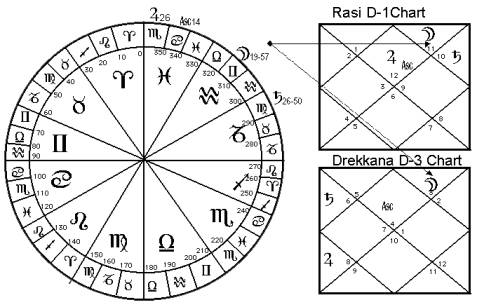
Thus, Lagna at 140 Pisces is in second Drekkana and is mapped into Cancer the fifth house from Pisces. Jupiter at 260 is in the third Drekkana of Pisces and this is Scorpio in the D-3 Chart. Moon is in the second Drekkana of Aquarius and is placed in Gemini in D-3 Chart. Saturn at 270 is in the third Drekkana of Capricorn and is mapped to the ninth house from Capricorn (i.e. Virgo) where it is placed in the D-3 Chart.
1.3.1 Nomenclature
The divisions of the zodiac and the divisional charts constructed on the basis of ownership of these divisions are named on various criteria. These include:
1. The division number: This is the numer by which the sign is divided into parts. For example ‘Saptamsa’ composed from Sapta meaning seven and amsa meaning portion. Thus, this is the one-seventh division of a sign.
2. Other reference numbers: For example, it is well known that there are 27 Nakshatra. Hence the name Nakshetramsa coined from Nakshatra and Amsa (portion) refers to the one – twenty seventh (1/27) division or the divisional chart prepared from this division occupied by the Lagna and nine planets.
3. Usage and focus: Every divisional chart (or division) has a specific use and a clearly defined focus on a specific area of activity. For example, Siddhamsa is coined from Siddha referring to that body of knowledge which a person learns and achieves perfection in and Amsa means portion. So, Siddhamsa refers to the division/divisional chart where we study the learning process. This is the 24th division (D-24 Chart). This is also called the Bhamsa from the word ‘Bha’ (as in Bha-chakra which is the primary representation of the zodiac as composed of 27 Nakshatra.
4. Multiple names: Divisions (D-charts) can have multiple names from either of the three aforementioned methods. For example the 16th division is called Shodasamsa [Shodas (sixteen) Amsa (portion)]. This is also called Kalamsa based on the 16 Kala’s in a 24-hour day.
5. Rao’s Method: The nomenclature introduced by Dr.K.N.Rao refers to each divisional chart directly by its division number. For example, the Siddhamsa is simply called the D-24 Chart or just D-24 when the division in the Rasi chart is being referred to.
Table 3 : Nomenclature
| Division | Primary Name | Other names |
| D-1 Chart | Rasi | Bhagana, Bha chakra |
| D-2 Chart | Hora | |
| D-3 Chart | Drekkana | |
| D-4 Chart | Chaturthamsa | Tureeyamsa |
| D-5 Chart | Panchamamsa | |
| D-6 Chart | Shastamsa | Kauluka |
| D-7 Chart | Saptamsa | |
| D-8 Chart | Astamsa | |
| D-9 Chart | Navamsa | Dharmamsa |
| D-10 Chart | Dasamsa | Swargamsa |
| D-11 Chart | Rudramsa | Labhamsa |
| D-12 Chart | Dwadasamsa | Suryamsa |
| D-13 to D-15 Charts Not used in Vedic Astrology | ||
| D-16 Chart | Shodasamsa | Kalamsa |
| D-17 to D-19 Charts | Not used in Vedic Astrology | |
| D-20 Chart | Vimsamsa | |
| D-21 to D-23 Charts | Not used in Vedic Astrology | |
| D-24 Chart | Siddhamsa | Chaturvimsamsa |
| D-25 to D-26 Charts | Not used in Vedic Astrology | |
| D-27 Chart | Nakshatramsa | Bhamsa, Saptavimsamsa |
| D-28 to D-29 Charts | Not used in Vedic Astrology | |
| D-30 Chart | Trimsamsa | |
| D-31 to D-39 Charts | Not used in Vedic Astrology | |
| D-40 Chart | Khavedamsa | Swavedamsa |
| D-41 to D-44 Charts | Not used in Vedic Astrology | |
| D-45 Chart | Akshavedamsa | |
| D-46 to D-59 Charts | Not used in Vedic Astrology | |
| D-60 Chart | Shastyamsa | |
| Some higher Divisional charts | ||
| D-72 Chart | Asta-Navamsa | |
| D-81 Chart | Nav-Navamsa | |
| D-108 Chart | Astottaramsa | Nav-Dwadasamsa, Dwadas-Navamsa, (are the two methods of chart construction), |
| D-144 Chart | Dwadas-Dwadasamsa | |
| D-150 Chart | Nadiamsa | Chandra-Kala Amsa |
| D-300 Chart | Ardha-Nadiamsa | |
1. Other systems: There are other totally different Varga Charts based on other criteria. Example – Astakavarga: The Varga charts constructed on the basis of the contribution of Rekha[22] and Bindu[23] by the eight factors (Lagna and seven planets from Sun to Saturn).
1.3.2 Technical terms
Like every other system, there are various technical terms used in the examination of Divisional charts. Getting accustomed to the verbiage helps in understanding and using the system.
1) Varga: Division or Divisional Chart in general usage.
- Amsa means portion and generally refers to the division of a sign. It also refers to individual D-charts when used in conjunction with the reference to the division. Example: Navamsa – Nav (Nine) + Amsa (division) refers to the one-ninth portion of a sign and the D-9 Chart specifically.
- Yoga means union and refers to the association of two bodies, whether mobile planets/Lagna or static signs in any of the four methods of Sambandha[24]. Any planet that brings about an association between the Lagna, Hora Lagna and Ghatika Lagna by ownership, placement or aspect is termed a Yogada.
- Subhapati: Subha means benefic and specifically refers to the Moon, as it is the sustainer of this life. Subhapati is the dispositor of the Moon and its dignity in the various divisional charts is examined to determine the health and longevity of the native. If the Subhapati aspects or conjoins the Lagna or Atmakaraka, it is elevated to the position of a Kevala. In addition if it associates with the Hora Lagna (HL) or Ghatika Lagna (GL) it is further elevated to a Kevala Yogada and if both HL and GL are also associated with the Kevala, then it is a Kevala Mahayogada.
- Karya Rasi is the house, which is the center of focus of the activity related to a Divisional chart. A D-chart may have many important houses like a Dasamsa where the sixth house is examined for service related matters or the seventh house is examined for business, but the focus is the tenth house and for the Dasamsa, the tenth house is the Karya Rasi. The Lord of the Karya Rasi in the Rasi Chart should be well placed in the concerned divisional chart for the activity (Karya) to prosper.
- Karyesh is the significator of the Karya (activity) and will vary from one chart to another depending on the activity involved. For example, in the Dasamsa (profession) a person can have many Karyesh depending on the activities he is involved in. As an example let us consider President Bill Clinton. He is a politician and also a lawyer. The Karyesh for politics is the Sun (note – Moon is for Bureaucracy) and that for a legal profession is Jupiter. Depending on the placement and strength of these planets in the Dasamsa, the rise or fall or changes in career can be studied and predicted. The concept of Argala is vital to determine as to which of these Karyesh shall bloom or perish at any point of time as the dasa’s change.
- Karaka means significator and are classified into the three categories of Naisargika, Chara and Sthira karaka. Details about Karaka and other basic principles like Rasi & Graha drishti, Argala etc, can be learnt from any standard book.
1.4 Harmonics
Since the twelve sign division is the primary division, it follows that all sub-division of the sign will fall in a sequence that repeats after every twelve divisions. Thus, for example, the D-16 Chart (Shodasamsa or Kalamsa) will be the first harmonic (or second cycle) of the D-4 Chart (Chaturthamsa). This can be expressed mathematically as 16 = (12 x 1)+ (4); where 1 represents the first harmonic. Similarly, the D-40 (Khavedamsa) Chart is the third harmonic (or 4th cycle) of the D-4 Chart as 40 = (12 x 3) + (4).
Table 4 : Divisional Charts Cycle
| Level of Consciousness | Cycle/ Harmonic | Divisional Charts range |
| Physical | Primary | (D-1 to D-12) |
| Conscious | Secondary/ First harmonic | (D-13 to D-24) |
| Sub-Conscious | Tertiary/ Second harmonic | (D-25 to D-36) |
| Super- Conscious | Quaternary/ Third harmonic | (D-37 to D-48) |
| Supra- Conscious | Pentenary/ Fourth harmonic | (D-49 to D-60) |
The first cycle of divisional charts from Rasi chart (D-1) to Dwadasamsa (D-12) rules over the physical plane and covers such matters as physical body (D-1), material wealth (D-2), brothers & sisters (D-3), immovable properties (D-4), children (D-7), authority over others (D-5), spouse (D-9), work (D-10) and parents (D-12). The second cycle or first harmonic rules over the conscious plane. Technically it covers charts D-13 to D-24, but Parasara has restricted the scope to the three primary areas of mental activity namely Shodasamsa or Kalamsa (D-16) ruling over matters of general mental happiness, luxuries, vehicles etc; Vimsamsa (D-20) wherein spiritualism, occult studies etc are examined and Chaturvimsamsa (D-24) for all kinds of learning (which is actually considered a heritage from the society). The third cycle or second harmonic rules over the sub-conscious plane covering charts D-25 to D-36. Parasara advises us to focus on two charts in this group, namely, Nakshetramsa (D-27) for strengths & weaknesses and Trimsamsa (D-30) for all evils. For example if the Moon is exalted and placed in a quadrant in the D-27 Chart, we can infer that the native is mentally very strong. A weak Mercury in this chart can show speaking disorders or a weak speech. The fourth cycle or third harmonic rules over the super-conscious plane covering charts D-37 to D-48. However, the good & bad accruing to the destiny of the individual due to the Matrilineal karma (seen from Khavedamsa D-40 Chart [as 40 = (12×3) + 4] and that from the Patrilineal Karma (seen from the Akshavedamsa D-45 Chart [as 45 = (12×3) + 9] are considered important in the Shodasavarga scheme of Parasara. The fifth cycle or fourth harmonic rules the supra-conscious plane covering the charts D-49 to D-60. At this level, the heritage (equivalent of D-12) of the karma from past births is relevant and the Shastyamsa (D-60 Chart) is vital. Parasara gives the highest weightage to this chart in the Shodasavarga scheme. There are much higher planes of Consciousness and some other divisional charts like the Nava-Navamsa (D-81), Ashtorramsa or Navamsa-Dwadasamsa (D-108) and Dwadasamsa-Dwadasamsa (D-144) are used.
Om Tat Sat
[1] Kala- time, Purusha – God personified as Man. Hence, Kalapurusha is the personification of time as the ultimate representation of God.
[2] Hence the name Rasi where Ra refers to the Sun God.
[3] Aho means day and Ratra means night.
[4] Kalyan Verma – Saravali 3.09”
[5] Kalyan Verma – Saravali 3.10
[6] Note that the term summer and winter refers to the northern hemisphere and is actually reversed in the southern hemisphere. The Summer solstice marks the end of summer i.e. when the Sun reaches its maximum northern latitude, whereas the winter solstice marks the end of winter when the Sun reaches its maximum southern latitude.
[7] Tropic of Cancer at 230 27’ N Latitude.
[8] Tropic of Capricorn at 230 27’ S Latitude.
[9] Different average rates of precession have been given for Ayanamsa, but the fact remains that Surya Siddhanta has been very close to the truth in using 24000 years!. The average rate is 360 Degrees divided by 25,800 years = 50.232558 seconds per year. Note also that the word is composed of ‘Ayana’ + ‘Amsa’ or literally, portion of the Ayana.
[10] Refer appendix-1 for details.
[11] Here we are referring to the Yogatara of Chitra.
[12] Chatuspada literally means four feet and also refers to the sign Sagittarius which is the ninth house representing ones fortune or Bhagya. The four feet of Dharma are defined as the duty towards (a) Universe/Nation (b) Society (c) Family and (d) self in that decreasing order of importance. It is noteworthy that Parasara uses the term ‘Bhagya’ while referring to the Chaturthamsa’s results.
[13] The Brhadaranyaka Upanishad explains the Karma theory with reference to the theory of Transmigration of the soul (samsara). The pious and good souls who have lived a dharmic life depart for the abode of the forefathers and other such loka. After a period of temporary bliss, they move on to emptiness via the Moon. From emptiness, they descend to the earth with the rain and enter the food that is consumed by the prospective father. From the food they become spermatozoa and are offered to the prospective mother in the altar of fire (copulation). Then the birth occurs. The Upanishad adds that the unrighteous are incarnated as birds, insects, animals or plants on the basis of the Karma of the past lives. It is generally taught that conduct and adherence to the moral code determined these changes. Thus good karma would promise an exalted future while bad karma will tend to degrade the soul in the lines of ‘ as you sow so will you reap’. This doctrine of Karma (literally “action”) provides a very satisfactory explanation for the various social inequalities that exist as well as the troubles or grief that one faces as it is the result of one’s own acts or misdeeds in the past. These Karma are divided into two categories called Sanchita and Prarabdha. The results of Sanchita Karma will be exhausted in the various heavens and hells after death whereas only experiencing them can lessen the results of Prarabdha Karma. Thus, it is this Prarabdha Karma, which is the cause of rebirth.
[14] indicated by Mukunda Daivagyna in Nasta Jataka
[15] Jupiter
[16] Snakes ruled by Rahu
[17] Pitri refers to the forefathers and when the Sun is in this place, in the Krishna Paksha (called Pitri Paksha), the devout Hindu worships the manes and forefathers.
[18] Others – Vishwakarma, Aditya etc.
[19] Water personified as the protector
[20] Vasudeva
[21] The ownership of individual divisions & signs by planets has been mentioned in traditional literature:
Trans: Mars, Venus, Merc, Moon, Sun, Merc, Ven, Mars, Jup, Saturn, Saturn & Jupiter are the lords of the 12 Rasi’s reckoned from Aries. These planets (in the said order also) lord the Amsa’s (Divisions). Vyankatesh Sharma – Sarvartha Chintamani (Sloka 1.06)
Kalyan Verma (Saravali Sloka 3.11)
[22] Rekha lit. vertical line
[23] Bindu lit. Dots. Thus, Rekha and Bindu refer to marks and dots contributed by the individual planets (and Lagna).
[24] Two planets can associate by (a) conjunction (b) mutual aspect (c) exchange of signs or constellations, or (d) aspect/placement in each others signs.
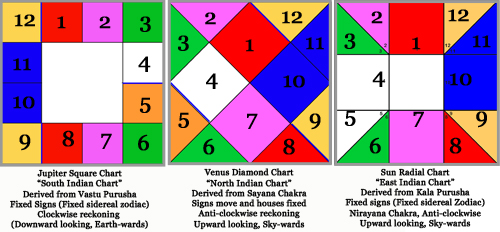
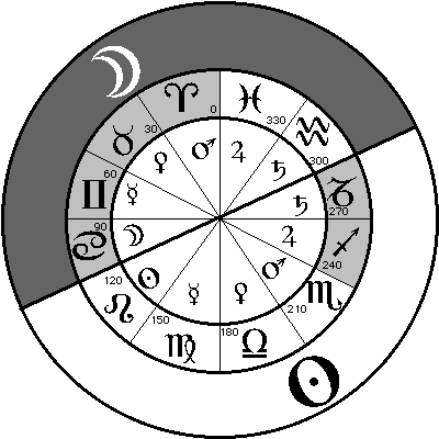
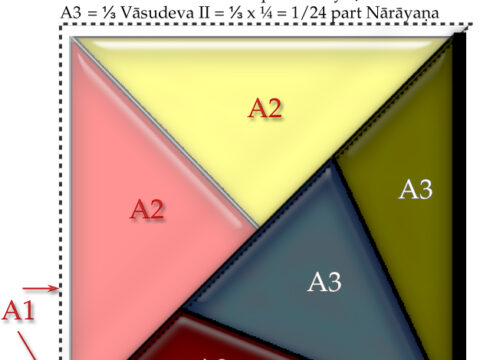

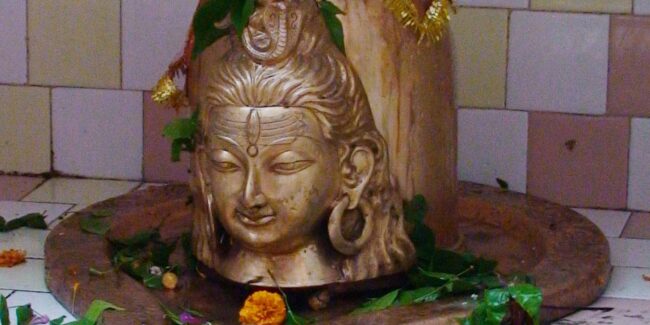
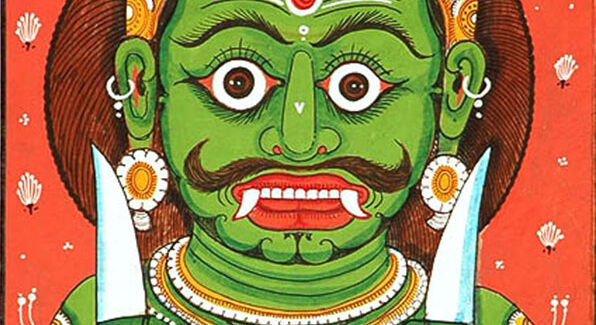
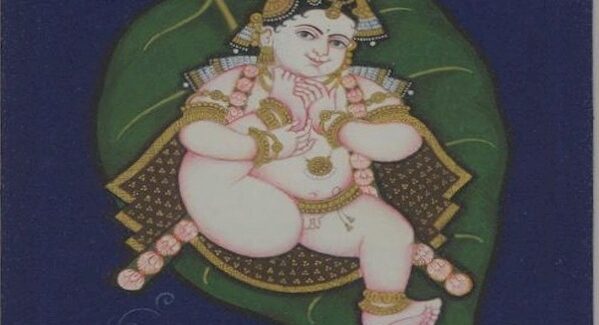
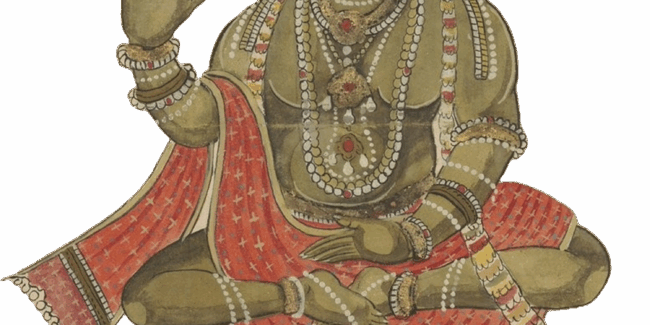
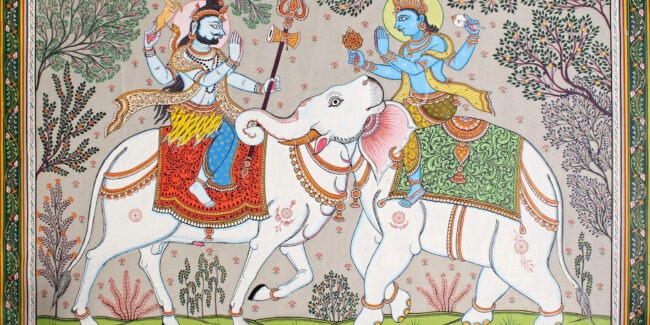
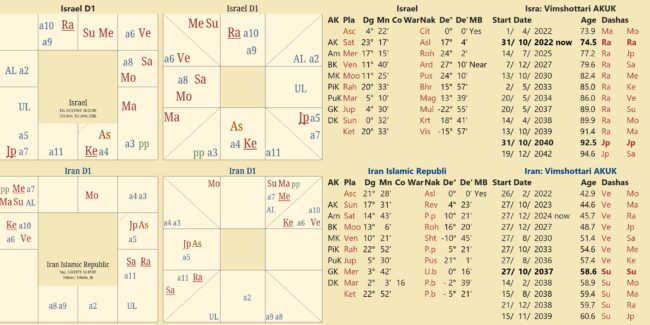
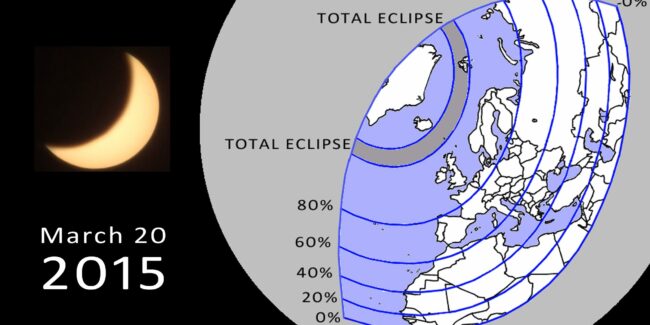

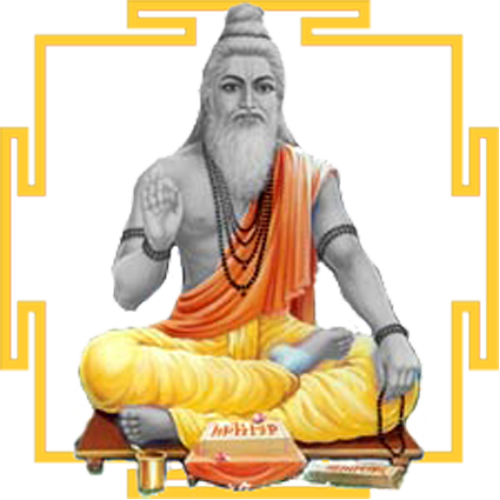 DBC offers online courses in jyotish (Vedic Astrology) taught directly by Sanjay Rath as per the tradition, through narrated power points and other audio tools. The courses are at different levels, from the beginners through the intermediate to the advanced and are known as SoHamsa | DBC courses, with individual classrooms and assistant teachers
DBC offers online courses in jyotish (Vedic Astrology) taught directly by Sanjay Rath as per the tradition, through narrated power points and other audio tools. The courses are at different levels, from the beginners through the intermediate to the advanced and are known as SoHamsa | DBC courses, with individual classrooms and assistant teachers
 Sagittarius Publications is the publisher and distributor the popular quaterly magazine the Jyotish Digest, as well as many thorough books on the subject of Vedic Astrology or Jyotish.
Sagittarius Publications is the publisher and distributor the popular quaterly magazine the Jyotish Digest, as well as many thorough books on the subject of Vedic Astrology or Jyotish. We have an excellent pandit Divākar ‘Deva’ Mishra, who is from the priests of Vindhyāvāsini Siddha Pīṭha to guide you through the hundreds of temples of Kāśi [Varanasi] and neighbouring regions. He can organise your pūjā, keep you safe and take care. He is supported by an English-speaking well-travelled spouse ‘Supriya Mishra’. Please contact them directly for any services, remedial pūjā and tours. They handled the 60+ member Kāśi Jyotiṣa Group 2022.
We have an excellent pandit Divākar ‘Deva’ Mishra, who is from the priests of Vindhyāvāsini Siddha Pīṭha to guide you through the hundreds of temples of Kāśi [Varanasi] and neighbouring regions. He can organise your pūjā, keep you safe and take care. He is supported by an English-speaking well-travelled spouse ‘Supriya Mishra’. Please contact them directly for any services, remedial pūjā and tours. They handled the 60+ member Kāśi Jyotiṣa Group 2022.
How to make this chart,i can’t find it anywhere
Every software has all three charts these days. Get Jagannath Hora Free and make it
प्रणाम। nothing to say sir. आपके बारे में उत्तमोत्तम शब्द का प्रयोग भी सूर्य को दिया दिखाना है। नमन
नमः शिवाय!
Dear Sunjay Ji, please accept my humble Namaskāram (Pranāma) from bottom of my heart! I’ve downloaded each & every video of yours that are available in YouTube. So much of profundity! You’ve been satisfying my hunger (like a mother) with each & every word in the video. I consider Knowledge as my wealth! It is very essential to me & of course very soul too.
I couldn’t exactly express my gratitude in the words what I’m feeling right now. But…
One thanks will not suffice.
Thanks for each & every word.
God bless!